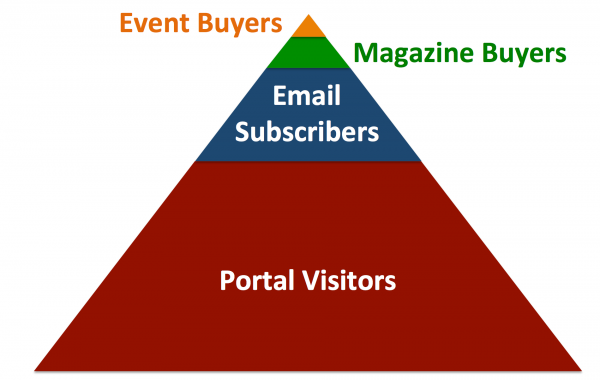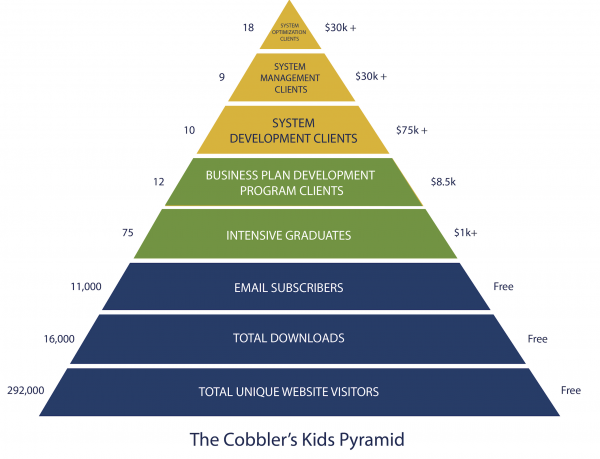The Mequoda Pyramid supports the notion that products have a natural hierarchy
Publishers implementing a vertically integrated strategy use outside media to acquire new customers, leveraging “free media” first. They use content to build a permission database. They create many products in many formats and recycle, reuse, and republish content. Finally, they are able to pull customers up the pyramid to maximize profit.
When you hear the word “pyramid” in the world of business, your thoughts may go in a different direction but at Mequoda, we’ve found a pyramid to be the best way to show how any publishing business makes money.
Why have we chosen the pyramid as a graphic symbol? Like an upside-down funnel, you have your largest audience at the bottom, typically your non-paid users, and as you grow toward the top, you can see how your users eventually convert into paid users for products at higher price points. Each succeeding audience is a smaller group accessing the platform, while their investment of time and money goes up.

In this example, visitors come to the portal (your website), convert into email subscribers, are monetized by turning into magazine buyers, and then climb to the top revenue-producing activity – event buying.
Ideally for any publishing website the largest percentage of your audience are visitors to your portal. These are the thousands or millions of website visitors who come in through search, social, and direct traffic. The next level of the pyramid is your email subscribers, because only a percentage of your visitors will convert into email subscribers, and an even smaller percentage will convert into paid magazine subscribers. Event attendees? Even fewer.
Publishers have many different levels to their pyramids, but this is one example of a simple product pyramid for a publisher that offers a magazine and events as premium products. The fundamental truth of the Mequoda Method is that attracting portal visitors is relatively easy if you have a disciplined approach to creating strong SEO content. And you can afford to serve your readers with high quality free content because a percentage of them will eventually pay by subscribing to your magazine or attending an event.
The Mequoda Group Pyramid
At Mequoda, we’re not publishers because we don’t sell information products, but we do practice everything we preach. We don’t have a magazine but we do have a pyramid.
Let me explain. Here is our pyramid, which we call the “Cobbler’s Kids,” because like the cobbler who doesn’t have time to make shoes for his kids, we constantly face the challenge of implementing our best practices for ourselves.

The data in this pyramid features a complete year of Mequoda’s numbers. On the left, you’ll see the number of people/subscribers/attendees/clients, and on the right, you’ll see how much money is charged at each level.
The lower levels of the pyramid, marked in blue, represent everything we do for free. If you just look at the blue, you might think of us as a publisher offering free content. Not coincidentally, it’s what the largest percentage of our audience gets to see: the Mequoda Daily portal, our free downloads, and our email newsletter. These are our audience development efforts, also known as our “marketing expenses.”
We spend about $200,000 a year generating content for the bottom of the pyramid, and we don’t charge anything for it.
The next step up on the pyramid, marked in green, is our live Intensive event, where people go to learn the Mequoda System (or train their employees on it), and our Business Development program – which are both value-priced. For this level, we generate around $165k per year, but spend more than $400k to produce them.
If you look at levels one through five, all revenue is spent on content creation, delivery, and client engagement.
They are lead generators to the top of the pyramid, and a marketing expense that we absorb. These levels are qualifiers. It’s where we ask people to spend some money with us, but it doesn’t cover the cost of the services being rendered.
The top of the pyramid, in yellow, funds the lower level pyramids. And like the yin and the yang, they give rise to one another. All the research we produce on the lower levels gives power to the top of the pyramid, where our development, management, and optimization clients are getting the most up-to-date consulting best practices and state of the art systems being built that are constantly evolving. Our clients at the top of the pyramid benefit from every level below them.
Currently, we spend 14% on marketing, but as you might assume, our version of marketing isn’t the same as other consultants. Instead of sponsoring other people’s events, we hold our own Intensives. Instead of paying to be featured on other people’s blogs, we write our own. Instead of sponsoring 3rd party company e-books, we produce and publish our own.
And compare that to other consultants who spend an average of 25% on marketing, typically outside of their company via sponsorships and ads. We not only keep our costs down, but our money is spent in a way that benefits our readers, subscribers, and especially our clients. Every nickel is spent to support the top of the pyramid.
If you look at all of our clients’ Mequoda Pyramids, you’ll notice a similar business philosophy, but with different products. Mequoda publishers distribute free content to build their email database to sell books, magazines, and events – Mequoda as an organization distributes free content to sell consulting and development services.
[text_ad]
Creating Your Own Mequoda Pyramid
The media pyramid enables us to identify, build, and manage a Mequoda System. Building a media pyramid is a fundamental strategy for modern publishers.
One of the first questions a publisher must answer for each platform is whether to use it for affinity content – i.e., content you will give away to build and maintain an audience – or for premium content, which you plan to sell.
The bottom of your pyramid: your portal visitors
The broad bottom of the pyramid represents the largest entry point. Most of the new users who will experience your brand will discover it on the Internet, either through a blog, portal, or community in a social network that you use as an audience aggregation mechanism.
Publishers use the Web to help users discover their website via organic search, give away content, and build a database. For example, a customer who has no prior knowledge of Interweave can Google “free sock patterns” and discover one of Interweave’s most successful portals, Knitting Daily, subscribe to its free email newsletter, and eventually become a premium product customer of this high-quality art and crafts publisher whose content includes magazines, books, TV Shows, ePatterns, and eProjects.
The next level of your pyramid: your email subscribers
The core use of this platform is the daily email newsletter.
The percent of all the users who visit your website, and offer up their email address to become email subscribers, are exponentially more committed to the brand.
Creating an email subscriber list using 3C Conversion Architecture is fundamental to the modern publisher’s marketing program. This is where the business relationship is launched, nurtured, and eventually monetized.
Most Mequoda System publishers send out a daily email newsletter; some also offer a week-in-review. All send regular email promotions, and many send third-party promotions too.
The next levels of your pyramid: all of the platforms that make you money, in order of price point
What do you sell? Books? Magazines? Software?
With the growing acceptance of tablets for reading, book sales are up, and book readership is climbing for the first time in decades.
A large part of the appeal of reading a book on an eReader or tablet computer is the lower cost — generally about $9.95 vs. two or three times that amount to purchase a hardcover book.
Digital book publishing is not encumbered by the economic concerns of revenue sharing, inventory storage, limited press runs, etc. Here again, digital production and distribution have driven costs downward, which will continue.
And naturally, your magazine is a level in this pyramid, which accounts for all of your single-copy and subscription sales. If you sell access to your website, or offer digital software with your publication, there’s a another level to add.
The Mequoda Pyramid is a core element of the Mequoda Method. Level by level, you monetize individuals by pushing them up the pyramid to product levels that are increasingly more valuable to them and certainly more profitable for you. And in case you’re wondering, this is true of purely sponsor-supported businesses, where users have higher levels of qualification in order to get access to higher levels of the pyramid, and sponsors pay more to gain access to those users.
Designing your enterprise in a Mequoda Pyramid is a dramatic departure for most media companies, which have historically been horizontally integrated as magazine, newsletter, or book publishers. During the past 30 years, we’ve seen special interest media evolve toward vertical integration in which the goal is to produce media in and for a variety of content platforms.
The top of your pyramid: your most expensive product
At the top of your pyramid is the product that drives the most amount of revenue, the product that the fewest number of all of those portal visitors will convert into buyers. For some, it might be a $99 special edition, and for others it might be a $2,500 conference ticket.
Events are at the top of the Mequoda Pyramid for many publishers. Events may include conferences that can have thousands of attendees, as well as B2B workshops and one-on-one consulting sessions. All of these are experiencing a renaissance, even though, with the exception of webinars, they are not digital.
Even with all of the connectivity and all of the digital products that the Internet now enables, the demand for live events – high-fidelity, personal face time – has never been greater. People who spend more time texting and tweeting than talking on the phone still crave live, social interaction with peers, mentors, and subject matter experts.
Publishers who have built their brand online are now discovering greater success at marketing their live events. Additionally, as database marketers, the cost of promoting live events with digital media is more affordable than ever.
Here are some tips for building (and implementing) your own media pyramid for use in your online business plan:
- Media products have a natural hierarchy
- This follows the time, money, and trust media continuum
- Use inbound marketing to acquire new customers
- Leverage “free media” first – SEO and social media is key
- Use content to build a permission database of email subscribers
- Portals and freebies are essential components of a niche media super-brand
- Create many products in many formats
- Recycle, reuse, and republish content
- Pull customers up the pyramid to maximize profit!
Work With Mequoda to Build Your Pyramid
For more than 15 years, the Mequoda team has helped publishing clients design and manage high-performance websites that deliver on their primary goals:
- To use free content to attract, convert, engage, and monetize users
- To sell and deliver premium content that generates revenue
- To build online communities that dominate their target markets
At Mequoda, we understand how search engines reward website design, and we know how to translate this knowledge into a compelling site that delivers an exceptional user experience. Our website design philosophy aligns premium content with free content. To do this, we first create a portal that is specifically designed to organically attract website visitors and convert them into email and social media followers. From there, our system shifts to selling premium information products, including subscriptions, books, videos, events, or third-party products and services.
Throughout the process, our primary goal remains constant: to architect a website that attracts users and maximizes revenues.


